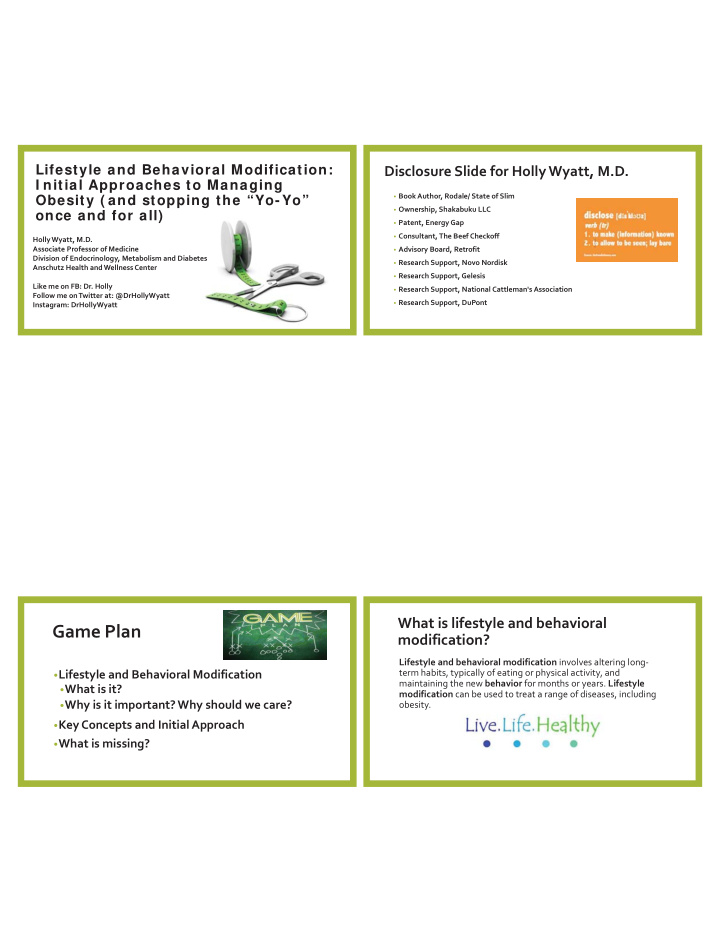



Lifestyle and Behavioral Modification: Disclosure Slide for Holly Wyatt, M.D. I nitial Approaches to Managing • Book Author, Rodale/ State of Slim Obesity ( and stopping the “Yo-Yo” • Ownership, Shakabuku LLC once and for all) • Patent, Energy Gap • Consultant, The Beef Checkoff Holly Wyatt, M.D. Associate Professor of Medicine • Advisory Board, Retrofit Division of Endocrinology, Metabolism and Diabetes • Research Support, Novo Nordisk Anschutz Health and Wellness Center • Research Support, Gelesis Like me on FB: Dr. Holly • Research Support, National Cattleman's Association Follow me on Twitter at: @DrHollyWyatt • Research Support, DuPont Instagram: DrHollyWyatt What is lifestyle and behavioral Game Plan modification? Lifestyle and behavioral modification involves altering long- • Lifestyle and Behavioral Modification term habits, typically of eating or physical activity, and maintaining the new behavior for months or years. Lifestyle • What is it? modification can be used to treat a range of diseases, including • Why is it important? Why should we care? obesity. • Key Concepts and Initial Approach • What is missing?
1. We need an enemy. Why is it important? • The cornerstone for long term success • Your lifestyle and behaviors produces your health AND happiness • Impacts your quality of life 2. Weight loss ≠ Weight Loss Maintenance Weight loss ≠ Weight Loss Maintenance Acute Weight Loss Strategy Weight Maintenance Chronic Weight Loss Strategy Weight Maintenance Weight Loss Strategy 1 Strategy 2 4-6 months Years/Forever?
How to think about weight loss versus weight loss maintenance • Weight Loss Maintenance • When adherence to a “diet” fades • Weight Loss • Long period of time • Finite period of time understanding physiology • Forever • 4-6 months becomes more important • Energy balance, matching intake to • Negative energy balance expenditure • Fat burning needed • Find a long-term strategy that • Metabolic flexibility needed • A reduction in calories is usually fights back against “biology” and • High levels of activity is usually required required “the environment” • More Success • Less Success What works for Weight Loss Comparison of weight loss diets with different Maintenance In the REAL World? compositions of fat, protein and carbohydrates (n=811) • National Weight Control Registry (NWCR) • Founded in 1993- Hill and Wing WEIGHT • Identified lifestyle modification practices for achieving and maintaining LOSS 0 weight loss -1 • Weight loss of at least 13.6 kg, sustained for a minimum of 1 year -2 weight loss (kg) -3 65/15/20% • COMMON CHARCTERISTICS 55/25/20% -4 • Eating breakfast every day- 78% 45/15/40% -5 WEIGHT • High levels of volitional physical activity- 90%, 1 hour a day 35/25/40% -6 • Reduced fat intake- 24% of calories from fat Re-GAIN -7 • Self monitoring of dietary intake and activity 0 6 12 18 24 • Consumption of low or no calorie sweeteners months • Regular self monitoring of weight- 75% weigh at least once a week Sacks FS. et al. NEJM 2009;360(9) 859-873 • Limiting TV viewing – 62% watched <10hrs/week National Weight Control Registry Website http://www.nwcr.ws/Research/default.htm
4. The Energy Gap 3. We Know WHAT to Do aka the Behavioral Gap But We Just Do NOT Do It Pre-Weight Loss Metabolic Rate Body Weight energy gap Post-Weight Loss Metabolic Rate Time Weight loss maintenance at high vs low Behavior Change is Hard energy expenditure (EE) Maintenance • Only 2.7% of adults met criteria of Restriction of Increased physical Drop in EE with energy intake activity weight loss • 1) healthy diet Food • 2) adequate physical activity Physical Restriction activity kcal/ 24 hr • 3) healthy weight • 4) non smoking After Before Before Before After After
What is Transformative Weight Loss? What is Missing? The process of creating and aligning a new reduced body weight, a positive and emotionally resilient mindset and your bigger purpose/spirit with a new lifestyle and way of being. LIFE TRANSFORMATION Begin With The End in Mind Mindset Choices and Skills • What I get to do versus what I am giving up • Believing I have the power to change versus believing I am Weight a victim to my life/circumstances Mindset Metabolism • Expecting success versus failure Activity Level • Finding and aligning your new life with your purpose and Nutrition values/your BIG WHY? Environment • Developing Emotional Resiliency Skills- bending versus Routines and Rituals breaking in rougher times Link to Purpose BIG Why? • Feeling Fear and Living in the Arena Your Identity Image By Abraham Sanogo CC BY-NC-SA 3.0
Aligning Your New Life with Your Create a Powerful Autopilot. Purpose –Your BIGGEST WHY? • Looking for connections between your weight • In todays world healthy behaviors takes planning loss goals/behaviors and your life and choices goals/purpose/Biggest Why? • It’s not the “default” • Listening to and behaving more in sync with • Sticking to your intentions requires willpower your inner self, who you want to be, how you • It is important for long-term success to make it as want to live your best life. easy as possible, to use the least amount of willpower • Identity shift
Recommend
More recommend